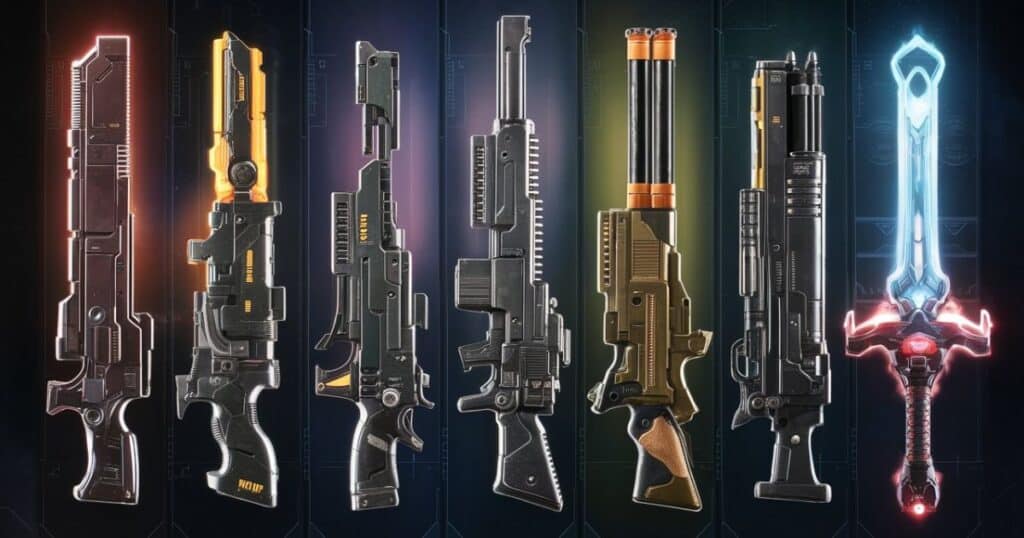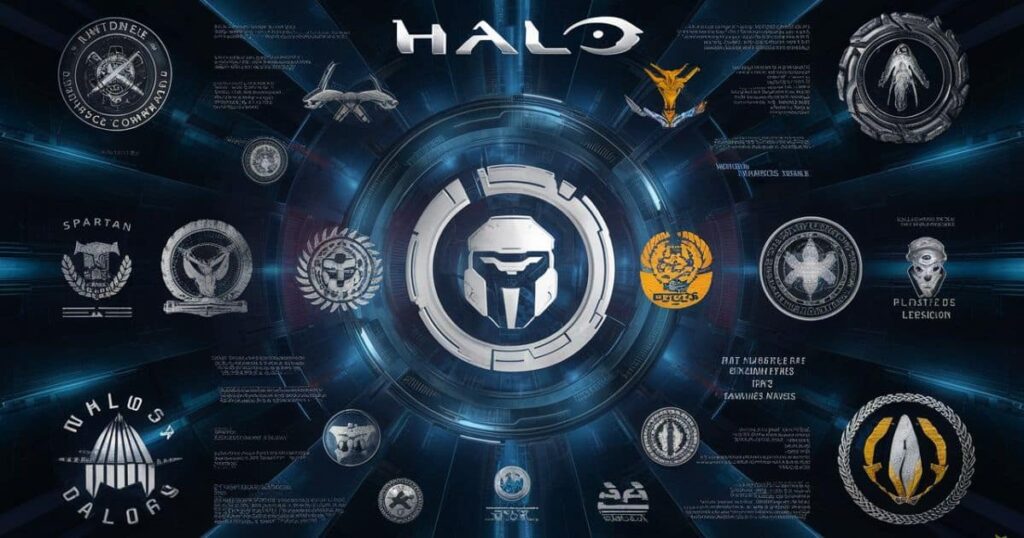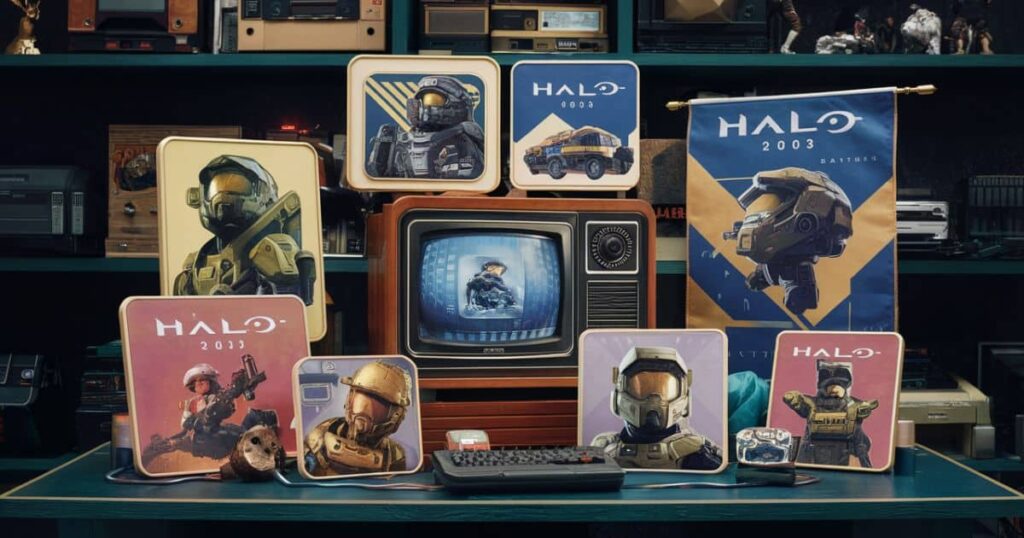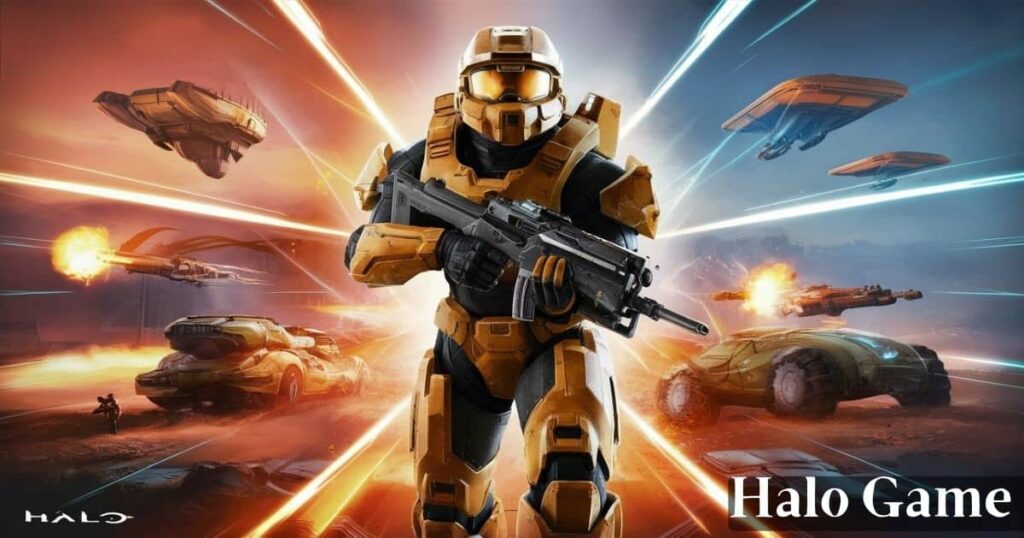Introduction to Halo (2003): A Classic First-Person Shooter
Halo (2003), developed by Bungie Studios and published by Microsoft Game Studios, revolutionized the first-person shooter genre upon its release for the Xbox console.
This groundbreaking game captured the hearts and minds of gamers worldwide, transporting them into a rich, science-fiction universe filled with intense combat, captivating storytelling, and breathtaking visuals.
At the center of this immersive experience were the iconic game icons and banners that have become ingrained in gaming culture.
Exploring the Legacy of Halo: Impact on Gaming Culture
Halo (2003) left an indelible mark on the gaming industry, transcending its status as a mere game and becoming a cultural phenomenon. Its innovative gameplay mechanics, such as the rechargeable energy shield and the ability to carry only two weapons at a time, redefined the first-person shooter experience. The game’s gripping narrative, which followed the adventures of the legendary Master Chief and his battle against the alien Covenant, captivated players and set new standards for storytelling in the genre.
Moreover, Halo (2003) pioneered the concept of seamless online multiplayer experiences, allowing gamers to engage in intense battles across a variety of meticulously crafted maps. This paved the way for a thriving competitive gaming scene and solidified the game’s place in the annals of gaming history.
Historical Context: Halo (2003) and the Evolution of Gaming Graphics
To truly appreciate the significance of Halo (2003) game icons and banners, it’s crucial to understand the technological advancements that enabled the game’s groundbreaking visuals. During the early 2000s, gaming graphics were undergoing a significant evolution, with developers pushing the boundaries of what was possible on consoles.
Halo (2003) stood at the forefront of this revolution, leveraging the power of the Xbox console to deliver unprecedented levels of detail and immersion. The game’s character models, environments, and visual effects were a quantum leap forward, leaving a lasting impression on gamers accustomed to the limitations of previous generations.
By harnessing cutting-edge rendering techniques and advanced lighting systems, Bungie Studios created a visually stunning world that felt alive and tangible. This attention to detail extended to the game’s iconic visual elements, including the meticulously crafted icons and banners that became an integral part of the Halo experience.
Overview of Halo (2003) Game Icons and Banners
Halo (2003) featured a diverse array of game icons and banners that served various purposes within the game’s user interface and beyond. These visual elements played a crucial role in helping players navigate the game’s mechanics, identify enemies and allies, and engage with the rich lore of the Haloverse.
The game’s icons represented a wide range of elements, including weapons, vehicles, equipment, grenades, and enemy types. Each icon was carefully designed to convey its function and significance within the game’s world, while adhering to a consistent visual style that became synonymous with the Halo franchise.
In addition to the icons, Halo (2003) featured a collection of banners and emblems that allowed players to forge their unique identities within the game’s multiplayer modes. These visual elements not only added a personalized touch to the gaming experience but also fostered a sense of community and camaraderie among players.
Importance of Game Icons and Banners in Gaming Marketing
Beyond their functional role within the game, icons and banners have become essential components of gaming marketing and branding strategies. These visual elements serve as powerful ambassadors for game franchises, helping to build brand recognition and foster emotional connections with fans.
In the case of Halo (2003), the iconic visual assets played a pivotal role in promoting the game and capturing the attention of potential players. The recognizable silhouette of the Master Chief, the sleek design of the Assault Rifle, and the imposing presence of the Scorpion tank became synonymous with the Halo brand, adorning merchandise, promotional materials, and fan-created content.
Furthermore, these visual elements helped to cultivate a dedicated fan base and create a sense of brand loyalty among the Halo community. Fans could proudly display their affiliation with the franchise through the use of Halo icons and banners, fostering a shared identity and deepening their connection to the game.
How to Download Halo (2003) Game Icons and Banners?
For those eager to obtain and utilize the iconic Halo (2003) game icons and banners, several reliable sources are available for legal and safe downloads. Here’s a step-by-step guide to help you get started:
- Visit the official Halo Waypoint website (https://www.halowaypoint.com/), maintained by 343 Industries, the current stewards of the Halo franchise.
- Navigate to the “Community” section and explore the various fan resources and downloadable content available.
- Search for “Halo (2003) game icons” or “Halo (2003) banners” in the search bar or browse through the relevant categories.
- Follow the instructions provided to download the desired assets, ensuring that you comply with any terms of use or licensing agreements.
Alternatively, you can explore reputable fan communities and forums dedicated to the Halo franchise, where enthusiasts often share and curate collections of game assets. However, it’s essential to exercise caution and verify the legitimacy of the sources to avoid any potential copyright infringements.
Once you have downloaded the desired Halo (2003) game icons and banners, be sure to organize the files in a logical manner for easy access and future use. Consider creating dedicated folders or utilizing file management software to keep your collection organized.
Related Post: The Ultimate Guide to What the Fluff Mobile Grooming?
Unveiling the Icons: A Look at Halo (2003) Game Icons and Banners
Weapon Icons
The weapon icons in Halo (2003) are among the most recognizable and iconic visual elements of the game. From the sleek and deadly Assault Rifle to the powerful and explosive Rocket Launcher, each weapon icon is meticulously designed to convey its function and lethality.

Halo (2003) Weapon Icons
One of the standout weapon icons is the Plasma Pistol, a Covenant energy weapon that could charge up and release a devastating blast. Its unique design, featuring a glowing blue core and intricate alien architecture, perfectly encapsulated the advanced technology of the Covenant forces.
Another iconic weapon icon is the Energy Sword, a deadly melee weapon favored by Covenant Elites. Its sleek, curved design and glowing energy blade instilled fear in opponents while also showcasing the elegance and lethal grace of the Elite warriors.
Vehicle Icons: Mastering the Battlefield on Wheels (and Tracks)
Halo (2003) introduced a wide array of vehicles, each with its own distinct capabilities and roles on the battlefield. The vehicle icons in the game not only served as visual identifiers but also conveyed the power and versatility of these mechanical marvels.
| Vehicle Icon | Vehicle Name | Description |
|---|---|---|
| Warthog | The iconic all-terrain transport, capable of mounting a powerful chaingun or rocket launcher. | |
| Scorpion Tank | The formidable main battle tank, equipped with a devastating 90mm cannon and robust armor. | |
| Banshee | The agile and deadly Covenant aerial assault craft, capable of raining plasma fire from above. |
The Warthog icon, with its rugged design and prominent chaingun turret, embodied the versatility and resilience of this iconic vehicle. The Scorpion Tank icon, featuring a menacing silhouette and imposing cannon, instilled a sense of awe and respect for its raw firepower.
Equipment and Grenade Icons: Mastering Your Arsenal on the Go
- Overshield Icon: Represented by a glowing blue sphere, the Overshield icon signified a temporary boost to the player’s shields, providing additional protection in combat.
- Active Camouflage Icon: Depicted as a fading silhouette, this icon indicated the ability to temporarily cloak and become nearly invisible, granting a tactical advantage in stealth situations.
- Frag Grenade Icon: The classic Frag Grenade icon featured a stylized depiction of the lethal explosive device, instantly recognizable to seasoned Halo players.
- Plasma Grenade Icon: Distinctly alien in design, the Plasma Grenade icon represented the volatile and deadly Covenant grenade, capable of adhering to surfaces and delivering a devastating blast.
These equipment and grenade icons not only served as visual cues but also embodied the versatility and adaptability required to excel on the battlefields of Halo (2003). Their designs seamlessly integrated into the game’s overall visual language, contributing to the immersive and cohesive experience.
Enemy Icons: Knowing Your Foe on the Battlefield
Halo (2003) introduced a diverse array of enemy factions, each with their own unique characteristics and abilities. The game’s enemy icons played a crucial role in helping players quickly identify and prepare for the threats they faced on the battlefield.
- Covenant Icons: The iconic Covenant enemy icons, such as the Elite, Grunt, and Jackal, featured sleek and angular designs that evoked a sense of advanced alien technology and military prowess.
- Flood Icons: Representing the virulent and terrifying Flood, these icons portrayed twisted and grotesque forms, conveying the horrific nature of this parasitic enemy.
By quickly recognizing these enemy icons, players could adapt their strategies and tactics accordingly, whether facing the disciplined ranks of the Covenant or the relentless onslaught of the Flood.
Multiplayer Banners and Emblems: Forging Your Identity in the Haloverse
One of the most exciting aspects of Halo (2003) was its groundbreaking multiplayer experience, which allowed players to compete against each other in intense battles across various maps and game modes. To personalize this experience, the game offered a wide range of multiplayer banners and emblems that players could choose to represent their unique identities.
These visual elements not only added a personal touch to the gaming experience but also fostered a sense of community and camaraderie among players. Showcasing a particular banner or emblem became a way to express one’s allegiance, achievements, or personal style within the Haloverse.
From the iconic “Duality” emblem, representing the balance between light and dark, to the sleek and stylized “Warrior” banner, these visual assets allowed players to forge their own distinct identities and leave their mark on the virtual battlefields of Halo (2003).
Analyzing the Visual Design of Halo (2003) Icons and Banners
The visual design of the Halo (2003) icons and banners was a masterclass in effective icon creation, adhering to principles of simplicity, consistency, and scalability. The game’s designers expertly leveraged a carefully curated color palette, featuring shades of green, blue, and metallic hues, to create a cohesive and instantly recognizable visual language.
One of the standout design choices was the use of bold, geometric shapes and clean lines, which not only conveyed a sense of futuristic technology but also ensured that the icons and banners remained legible and recognizable, even at smaller scales or in cluttered user interfaces.
Additionally, the designers employed clever use of negative space and silhouettes, allowing the icons to convey their intended meanings without relying on excessive detail or ornamentation. This minimalistic approach contributed to the timeless appeal of the Halo (2003) visual assets, ensuring that they remain iconic and relevant even years after the game’s initial release.
Halo (2003) Iconography: Symbols and Significance

Beyond their functional and visual appeal, the icons and banners of Halo (2003) carried deeper symbolic meanings and cultural significance. Many of these visual elements drew inspiration from real-world symbols, mythologies, and cultural traditions, adding layers of depth and resonance to the game’s narrative and world-building.
For instance, the iconic “Reclaimer” symbol, which featured prominently throughout the game, was inspired by ancient Greco-Roman imagery and represented the idea of humanity reclaiming its rightful place in the universe. This symbol not only served as a visual motif but also tied into the overarching narrative of the Halo universe, where humanity’s role as the inheritors of the Forerunner legacy was a central theme.
Similarly, the emblems and banners used in multiplayer modes often drew upon ancient heraldic symbols and iconography, evoking a sense of tradition and honor among players. These visual elements became symbols of allegiance, achievement, and camaraderie, transcending their purely functional roles within the game.
By incorporating these symbolic elements, the designers of Halo (2003) created a rich and immersive world that resonated with players on a deeper level, elevating the game’s visual assets from mere icons and banners to cultural artifacts imbued with meaning and significance.
Utilizing Halo (2003) Game Icons and Banners for Fan Content
The enduring popularity and cultural impact of Halo (2003) have spawned a vibrant and dedicated fan community, with countless artists, creators, and enthusiasts contributing their own unique interpretations and tributes to the game. One of the most common ways for fans to express their love for the Haloverse is through the incorporation of game icons and banners into their creative projects.
Fan art, ranging from digital illustrations to physical sculptures and paintings, often features the iconic visuals from Halo (2003), such as the Master Chief’s helmet, the Assault Rifle, or the emblematic “Duality” emblem. These visual elements serve as powerful symbols that instantly evoke the spirit and essence of the game, resonating deeply with fans worldwide.
Beyond traditional art forms, fans have also utilized Halo (2003) icons and banners in a variety of other creative endeavors. Video content creators, such as YouTube vloggers and streamers, often incorporate these visual elements into their channel branding, thumbnails, and overlays, creating a strong visual association with the Halo franchise.
Web designers and developers have also embraced the iconic Halo visuals, using them to create stunning website designs, user interfaces, and other digital experiences that pay homage to the game.
However, it’s crucial for fans to respect intellectual property rights and adhere to any applicable licensing agreements when utilizing these visual assets. Many game studios, including 343 Industries, have established guidelines and policies for the use of their intellectual property, ensuring that fan creations remain within legal boundaries while still allowing for creative expression.
By following these guidelines and properly crediting the source material, fans can continue to celebrate and pay tribute to the enduring legacy of Halo (2003) while also fostering a respectful and collaborative relationship with the game’s creators and rights holders.
Preserving the Nostalgia: Collecting Halo (2003) Icons and Banners

As the years pass and new iterations of the Halo franchise are released, the visual assets from Halo (2003) have become highly sought-after collectibles among fans and gaming enthusiasts. These iconic icons and banners represent a pivotal moment in gaming history, capturing the essence of a groundbreaking title that reshaped the industry.
Collecting and archiving these visual assets has become a passion for many, who seek to preserve the nostalgia and cultural significance of Halo (2003) for future generations. Collectors scour various sources, from official merchandise releases to fan-curated archives, in pursuit of rare or limited-edition assets that capture the game’s iconic visuals.
One popular avenue for collectors is the acquisition of physical merchandise featuring Halo (2003) icons and banners. From t-shirts and posters to intricate figurines and statues, these tangible items not only serve as displayable pieces but also represent the enduring legacy of the game.
In the digital realm, collectors often curate extensive archives of high-quality icon and banner files, meticulously organized and preserved for posterity. These digital collections serve as invaluable resources for researchers, historians, and fans alike, ensuring that the visual heritage of Halo (2003) remains accessible and celebrated.
Preserving these visual assets is not merely an act of nostalgia but also a testament to the profound impact that Halo (2003) had on the gaming industry and popular culture. By safeguarding these iconic visuals, collectors and enthusiasts ensure that the game’s legacy lives on, inspiring future generations of gamers and artists alike.
“The icons and banners of Halo (2003) are more than just visual elements; they are symbols of a gaming revolution that captured the imaginations of millions. Collecting and preserving these assets is not only a way to honor the past but also to ensure that the spirit of Halo endures for generations to come.” – Marcus Lehto, Former Art Director at Bungie Studios
As former Bungie Art Director Marcus Lehto eloquently stated, the act of collecting and preserving Halo (2003) icons and banners transcends mere nostalgia. It is a commitment to safeguarding the cultural heritage of a game that redefined the boundaries of what was possible in the industry.
By carefully curating and archiving these visual assets, collectors and enthusiasts play a crucial role in ensuring that the pioneering spirit and groundbreaking innovations of Halo (2003) are never forgotten. These icons and banners serve as tangible reminders of the game’s lasting impact and its enduring place in the annals of gaming history.
Conclusion: A Look at Halo (2003) Game Icons and Banners
Halo (2003) was not merely a game; it was a cultural phenomenon that redefined the gaming landscape and captivated millions of players worldwide. At the heart of this groundbreaking title were the iconic game icons and banners that have become ingrained in the collective consciousness of gamers and pop culture enthusiasts alike.
These visual elements served as more than just functional components within the game; they were meticulously crafted works of art that conveyed the essence of the Haloverse. From the sleek and deadly weapon icons to the imposing vehicle silhouettes and the intricate multiplayer emblems, each visual asset contributed to the immersive and cohesive experience that made Halo (2003) a true masterpiece.
As we reflect on the enduring legacy of this classic game, it becomes evident that the icons and banners have transcended their original purpose. They have evolved into cultural artifacts, representing the pioneering spirit and technological advancements that pushed the boundaries of what was possible in gaming.
Moreover, these visual elements have become symbols of unity and camaraderie among the dedicated Halo fan community. They serve as rallying points for artists, creators, and enthusiasts who seek to pay tribute to the game that captured their imaginations and inspired their creativity.
As we look towards the future, the importance of preserving and celebrating the visual heritage of Halo (2003) cannot be overstated. These icons and banners are not merely relics of the past but living testaments to the power of innovation, storytelling, and artistic expression.
By embracing and cherishing these visual assets, we honor the legacy of Halo (2003) and ensure that its impact continues to resonate for generations to come, inspiring new waves of gamers and creators to push the boundaries of what is possible in interactive entertainment.






